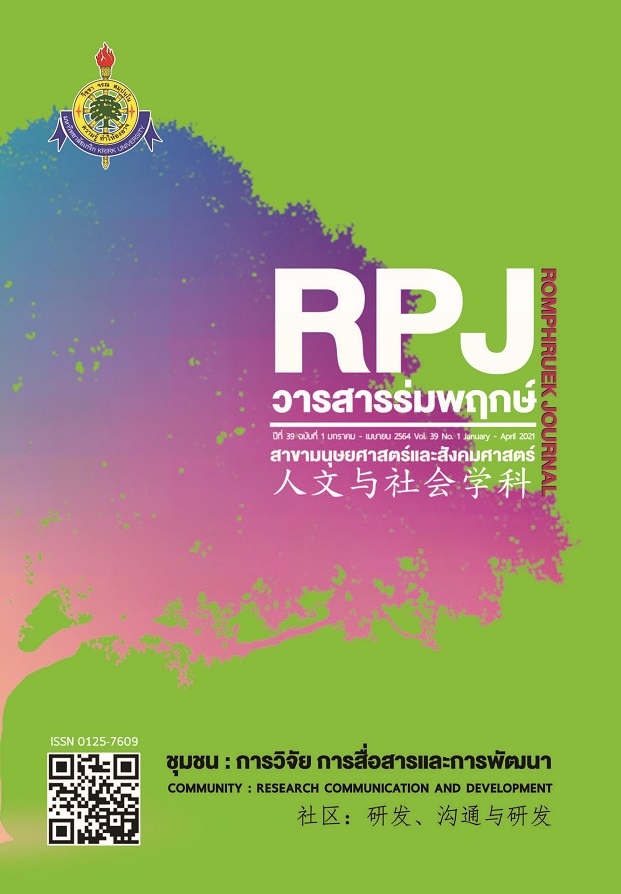Potential Development of Housewife Group who Produce Community Products through Participation of the Community in Lak Si District, Bangkok
Main Article Content
Abstract
The objectives of this research were to 1) analyze the factors affecting the potential development of the housewife group who produce the community products of Ruam Pattana Community in Laksi District, Bangkok, 2) analyze the marketing factors affecting the product development of the housewife group who produce community products of Ruam Pattana Community in LakSi District, Bangkok, and 3) analyze the potential development pattern of the housewife group who produce the community products through the participation of Ruam Pattana Community in LakSi District. The Community-Based Research (CBR) methodology was used for this research. The research instruments included 1) individual in-depth interviews, 2) SWOT Analysis, 3) focus group discussions with the community leaders, and community development workers, etc., and 4) a questionnaire. The data received from individual in-depth interviews, focus group discussions, community forum, workshops and field trips were collected and analyzed.
The results of the research were: There were seven factors affecting the potential development of the housewife group who produce the community products of Ruam Pattana Community in Laksi District, Bangkok. These were: the demographic factors, the factors of age, manufacturing process, management, compensation, motivation and morale, marketing, and values. The analysis of the marketing factors affecting the potential development of the housewife group who produce the community products of Ruam Pattana Community in LakSi District, Bangkok showed that the 9 P’s Marketing Factors Product, Price, Place, Promotion, People, Process, Physical evidence, Packaging, and Power were investigated. And The analysis of the potential development pattern of the housewife group who produce community products through the participation of Ruam Pattana Community revealed that the activity implementation enabled to set the potential development pattern of the community products through the participation of Ruam Pattana Community which were consisted of three main factors, these were: the potential development factor; the process of the potential development through the community participation; and the potentiality of the housewife group.
Article Details
Every article published in the Romphruek Journal of the Humanities and Social Sciences is the opinion and point of view of the authors. Thery're not the viewpoint of Krirk University or the editored department. Any part or all of the articles for pablication must be clearly cited.
References
กรมการพัฒนาชุมชน. (2527). การพัฒนาชุมชน. กรุงเทพฯ : กรมการพัฒนาชุมชน.
กลยุทธ์การตลาดที่เหมาะสม. (2561). กลยุทธ์การตลาดออนไลน์. (9 เมษายน 2561) เข้าถึงได้จาก https://www.igitalgeek.com/ blog/.
เกษราพร ทิราวงศ์ และ อำนวยพร ใหญ่ยิ่ง. (2552). การพัฒนาศักยภาพชุมชนบ้านแม่แรม ตำบลเตาปูน อำเภอสอง จังหวัดแพร่ ด้วยการท่องเที่ยวเชิงนิเวศ เพื่อสร้างความเข้มแข็งของชุมชนอย่างยั่งยืน. มหาวิทยาลัยแม่โจ้, เชียงใหม่.
ญาณัญฎา ศิรภัทร์ธาดา. (2553.) การพัฒนาพฤติกรรมการเรียนและผลสัมฤทธิ์ทางการเรียนการสอนของนักศึกษาในการเรียนวิชาหลักการตลาด โดยการสอนแบบมีส่วนร่วม (Active Learning). คณะบริหารธุรกิจ มหาวิทยาลัยราชภัฏสวนสุนันทา, กรุงเทพฯ.
นุชจรี ทิวาวัลย์ และคณะ. (2547). ภูมิปัญญาท้องถิ่น : การจัดการความรู้ ศูนย์ศึกษาและพัฒนาชุมชน ชลบุรี กรมการพัฒนาชุมชน. (30 พฤษภาคม 2559) สืบค้นจาก www3.cdd.go.th/ cdregion02/goodstory/nut.doc
พรรณราย ทรัพยะประภา. (2534). จิตวิทยาสำหรับนักบริหาร. พิมพ์ครั้งที่ 3. กรุงเทพฯ : สำนักพิมพ์พิมพลักษณ์.
พีรญา ตั้งสกุล. (2553). แนวทางการพัฒนาศักยภาพในการปฏิบัติงานของบุคลากร องค์การบริการส่วน ตำบลพระครู อำเภอเมืองบุรีรัมย์ จังหวัดบุรีรัมย์. วิทยาลัยการปกครองท้องถิ่น มหาวิทยาลัยขอนแก่น, ขอนแก่น.
รัตนา ดือเระซอ และคณะ. (2556). แนวทางการพัฒนาอาชีพการทำผลิตภัณฑ์จักสานเพื่อสร้างรายได้เสริม กลุ่มแม่บ้านปะกาลิมาปูโระ ตำบลบาราเฮาะ อำเภอเมือง จังหวัดปัตตานี. (25 พฤษภาคม 2559) สืบค้นจาก https://elibrary.trf.or.th/downloadFull. asp?proid=PDG6120003.
ศักดิ์ศิริ นันตะสุข และคณะ. (2550). การพัฒนาศักยภาพสิ่งทอชุมชน จังหวัดชัยภูมิ. (8 เมษายน 2559) สืบค้นจาก https://elibrary.trf.or.th/downloadFull.asp? proid=PDG6120003.
สนธยา พลศรี. (2547). ทฤษฎีและหลักการพัฒนาชุมชน. พิมพ์ครั้งที่ 5. กรุงเทพฯ : สำนักพิมพ์พิมพ์ลักษณ์.
สมชาย น้อยฉ่ำ และคณะ. (2561). การบริหารจัดการวิสาหกิจชุมชน อำเภออัมพวา จังหวัดสมุทรสงคราม. วารสารเกษมบัณฑิต, 19(ฉบับพิเศษ), 130-139.
สมยศ นาวีการ. (2529). การเพิ่มประสิทธิภาพของการบริหาร : MPO. กรุงเทพฯ : บรรณกิจ.
สุดาพร กุณฑลบุตร. (2557). หลักการตลาดสมัยใหม่. กรุงเทพฯ : โรงพิมพ์แห่งจุฬาลงกรณ์มหาวิทยาลัย.
สุธีรา ไชยเทพ. (2549). การดําเนินงานของวิสาหกิจชุมชนกลุ่มผลิตภัณฑ์อาหารในจังหวัดเชียงใหม่. บัณฑิตวิทยาลัย มหาวิทยาลัยเชียงใหม่, เชียงใหม่.
สุรีรัตน์ ธรรมจง และคณะ. (2562). ปัจจัยที่มีอิทธิพลต่อการตัดสินใจเลือกซื้อสินค้าบนสื่อสังคมออนไลน์ของผู้บริโภคกลุ่มคนเหงา. วารสารมนุษยศาสตร์และสังคมศาสตร์ มหาวิทยาลัยเอเชียอาคเนย์, 3(2), 54-65.
สำนักงานเขตหลักสี่. (2559). ข้อมูลทั่วไปของเขต. (18 พฤษภาคม 2559) สืบค้นจาก http://www.bangkok.go.th/laksi.
อภิสรา ชุ่มจิตร นิศา ชัชกุล และ เครือวัลย์ ชัชกุล (2557). การพัฒนาศักยภาพการจัดการธุรกิจชุมชน กรณีศึกษา : ตำบลคลองเคียน อำเภอตะกั่วทุ่ง จังหวัดพังงา. วารสารวิชาการมหาวิทยาลัยราชภัฏภูเก็ต, 10(2), 94-115.
Kotler, P., & Keller, K. L. (2016). Marketing Management. (14th ed.). New Jersey : Prentice Hall.
Lovelock, C. and Wright, L. (2002). Principles of Service Marketing and Management. (2nd ed.). New Jersey : Prentice Hall.
Lovelock, C. and Wirtz, J. (2007). Principles of Service Marketing and Management : People, Technology, Strategy. (6th ed.). New Jersey : Pearson/Prentice Hall.


